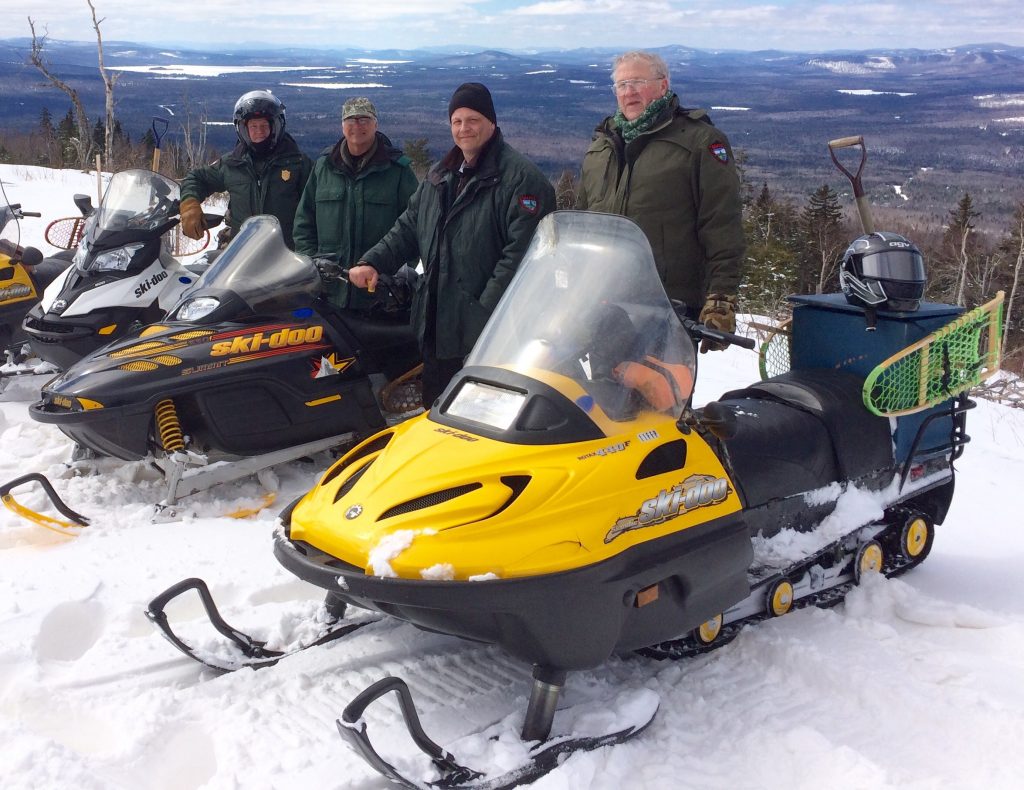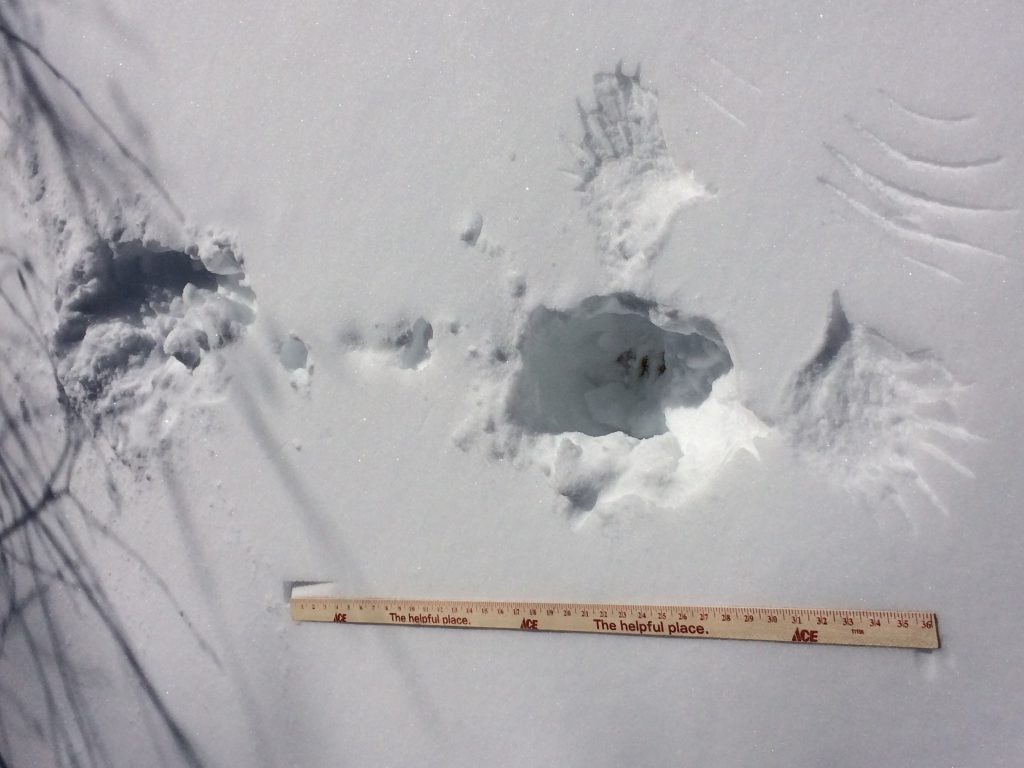April 5, 2017 at 9:24 am
By Chuck Hulsey, Wildlife Biologist, Region D
Regional wildlife biologists in the northern half of Maine are in winter number three of a project to extensively survey selected townships for Canada lynx. So far this year Assistant Regional Wildlife Biologist Bob Cordes and I have surveyed Mayfield Township, Tim Pond Township, Upper Cupsuptic Township, and Redington Township. Spring Lake Township was surveyed for us by the regional wildlife biologists from Region A, headquartered in Gray. On each of the surveys we documented one or two sets of lynx tracks.
[caption id="attachment_2236" align="aligncenter" width="487"] (L-R) Warden Scott Stevens, Retired Warden Blaine Holding, Wildlife Biologist Bob Cordes, Wildlife Biologist Chuck Hulsey on Quill Hill in Redington Township.[/caption]
Protocol requires that surveys be run during a 48-hour window, commencing 24 hours after the cessation of a snow storm or significant winds. Then, within that window the survey of 55-80 kilometers (33-48 miles) has to be fully completed, or if not, re-run another time. The essence of this restriction was to limit and standardize the amount of time animals could run around leaving tracks in fresh snow. Eliminating all tracks made before the survey helps in assessing numbers. We also took advantage of the opportunity to assess the abundance of snowshoe hare and bobcat, the former being the prime food source for lynx as well as the soup du jour for many other predators.
[caption id="attachment_2237" align="aligncenter" width="523"]
(L-R) Warden Scott Stevens, Retired Warden Blaine Holding, Wildlife Biologist Bob Cordes, Wildlife Biologist Chuck Hulsey on Quill Hill in Redington Township.[/caption]
Protocol requires that surveys be run during a 48-hour window, commencing 24 hours after the cessation of a snow storm or significant winds. Then, within that window the survey of 55-80 kilometers (33-48 miles) has to be fully completed, or if not, re-run another time. The essence of this restriction was to limit and standardize the amount of time animals could run around leaving tracks in fresh snow. Eliminating all tracks made before the survey helps in assessing numbers. We also took advantage of the opportunity to assess the abundance of snowshoe hare and bobcat, the former being the prime food source for lynx as well as the soup du jour for many other predators.
[caption id="attachment_2237" align="aligncenter" width="523"] Snow roosting grouse site[/caption]
Conducting lynx surveys from a snowmobile is usually very enjoyable duty. Some days can be rough however if the survey window occurs when it is really cold. Having done day-long surveys at sub-zero temperatures makes us really appreciate our last survey a little over a week ago. Temperatures that day were around 30 degrees and sunny. Our survey covered the southern half of Coplin Plantation and the northern half of neighboring Redington Township. This area is immediately west of Sugarloaf Mountain. Bob and I were assisted on this day by District Game Warden Scott Stevens and retired game warden Blaine Holding. Scott replaced Blaine in this district upon his retirement. With these two helping us, Bob and I had little need for our maps to navigate the backcountry.
In closing, doing wildlife track surveys immediately following a fresh snow paints a pretty good picture of what is happening around us. Snowshoe hare tracks are common, as are moose. Because we were not in any deer wintering areas, we saw no deer tracks. On almost every survey we see pine marten and fisher, and sometimes the smallest member of that family, weasels. Here is an image I took which captures a behavioral strategy to avoid the effects of very cold temperatures. Do you know what made these impressions in the snow? The lower hole is where the animal exited.
Snow roosting grouse site[/caption]
Conducting lynx surveys from a snowmobile is usually very enjoyable duty. Some days can be rough however if the survey window occurs when it is really cold. Having done day-long surveys at sub-zero temperatures makes us really appreciate our last survey a little over a week ago. Temperatures that day were around 30 degrees and sunny. Our survey covered the southern half of Coplin Plantation and the northern half of neighboring Redington Township. This area is immediately west of Sugarloaf Mountain. Bob and I were assisted on this day by District Game Warden Scott Stevens and retired game warden Blaine Holding. Scott replaced Blaine in this district upon his retirement. With these two helping us, Bob and I had little need for our maps to navigate the backcountry.
In closing, doing wildlife track surveys immediately following a fresh snow paints a pretty good picture of what is happening around us. Snowshoe hare tracks are common, as are moose. Because we were not in any deer wintering areas, we saw no deer tracks. On almost every survey we see pine marten and fisher, and sometimes the smallest member of that family, weasels. Here is an image I took which captures a behavioral strategy to avoid the effects of very cold temperatures. Do you know what made these impressions in the snow? The lower hole is where the animal exited.
 (L-R) Warden Scott Stevens, Retired Warden Blaine Holding, Wildlife Biologist Bob Cordes, Wildlife Biologist Chuck Hulsey on Quill Hill in Redington Township.[/caption]
Protocol requires that surveys be run during a 48-hour window, commencing 24 hours after the cessation of a snow storm or significant winds. Then, within that window the survey of 55-80 kilometers (33-48 miles) has to be fully completed, or if not, re-run another time. The essence of this restriction was to limit and standardize the amount of time animals could run around leaving tracks in fresh snow. Eliminating all tracks made before the survey helps in assessing numbers. We also took advantage of the opportunity to assess the abundance of snowshoe hare and bobcat, the former being the prime food source for lynx as well as the soup du jour for many other predators.
[caption id="attachment_2237" align="aligncenter" width="523"]
(L-R) Warden Scott Stevens, Retired Warden Blaine Holding, Wildlife Biologist Bob Cordes, Wildlife Biologist Chuck Hulsey on Quill Hill in Redington Township.[/caption]
Protocol requires that surveys be run during a 48-hour window, commencing 24 hours after the cessation of a snow storm or significant winds. Then, within that window the survey of 55-80 kilometers (33-48 miles) has to be fully completed, or if not, re-run another time. The essence of this restriction was to limit and standardize the amount of time animals could run around leaving tracks in fresh snow. Eliminating all tracks made before the survey helps in assessing numbers. We also took advantage of the opportunity to assess the abundance of snowshoe hare and bobcat, the former being the prime food source for lynx as well as the soup du jour for many other predators.
[caption id="attachment_2237" align="aligncenter" width="523"] Snow roosting grouse site[/caption]
Conducting lynx surveys from a snowmobile is usually very enjoyable duty. Some days can be rough however if the survey window occurs when it is really cold. Having done day-long surveys at sub-zero temperatures makes us really appreciate our last survey a little over a week ago. Temperatures that day were around 30 degrees and sunny. Our survey covered the southern half of Coplin Plantation and the northern half of neighboring Redington Township. This area is immediately west of Sugarloaf Mountain. Bob and I were assisted on this day by District Game Warden Scott Stevens and retired game warden Blaine Holding. Scott replaced Blaine in this district upon his retirement. With these two helping us, Bob and I had little need for our maps to navigate the backcountry.
In closing, doing wildlife track surveys immediately following a fresh snow paints a pretty good picture of what is happening around us. Snowshoe hare tracks are common, as are moose. Because we were not in any deer wintering areas, we saw no deer tracks. On almost every survey we see pine marten and fisher, and sometimes the smallest member of that family, weasels. Here is an image I took which captures a behavioral strategy to avoid the effects of very cold temperatures. Do you know what made these impressions in the snow? The lower hole is where the animal exited.
Snow roosting grouse site[/caption]
Conducting lynx surveys from a snowmobile is usually very enjoyable duty. Some days can be rough however if the survey window occurs when it is really cold. Having done day-long surveys at sub-zero temperatures makes us really appreciate our last survey a little over a week ago. Temperatures that day were around 30 degrees and sunny. Our survey covered the southern half of Coplin Plantation and the northern half of neighboring Redington Township. This area is immediately west of Sugarloaf Mountain. Bob and I were assisted on this day by District Game Warden Scott Stevens and retired game warden Blaine Holding. Scott replaced Blaine in this district upon his retirement. With these two helping us, Bob and I had little need for our maps to navigate the backcountry.
In closing, doing wildlife track surveys immediately following a fresh snow paints a pretty good picture of what is happening around us. Snowshoe hare tracks are common, as are moose. Because we were not in any deer wintering areas, we saw no deer tracks. On almost every survey we see pine marten and fisher, and sometimes the smallest member of that family, weasels. Here is an image I took which captures a behavioral strategy to avoid the effects of very cold temperatures. Do you know what made these impressions in the snow? The lower hole is where the animal exited.Categories